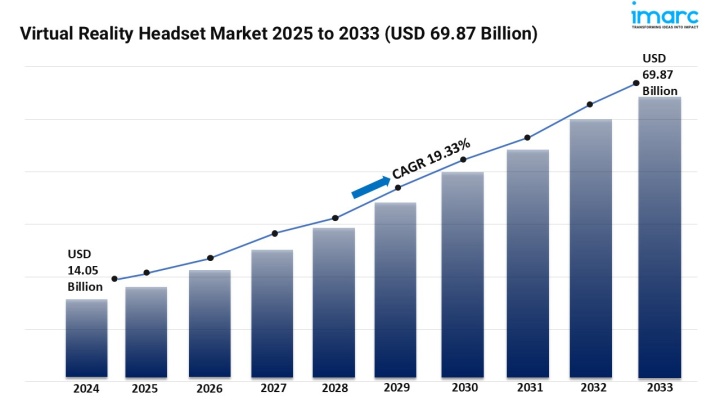

Market Overview:
The virtual reality headset market is experiencing rapid growth, driven by Expanding Enterprise and Commercial Applications, Advancements in Hardware and Affordability and A Surge in Demand for Immersive Entertainment. According to IMARC Group’s latest research publication, “Virtual Reality Headset Market Size, Share, Trends and Forecast by Product, Material, End User, and Region, 2025-2033“, offers a comprehensive analysis of the industry, which comprises insights on the global virtual reality headset market share. The market size was valued at USD 14.05 Billion in 2024. The market is projected to reach USD 69.87 Billion by 2033, exhibiting a CAGR of 19.33% during 2025-2033.
This detailed analysis primarily encompasses industry size, business trends, market share, key growth factors, and regional forecasts. The report offers a comprehensive overview and integrates research findings, market assessments, and data from different sources. It also includes pivotal market dynamics like drivers and challenges, while also highlighting growth opportunities, financial insights, technological improvements, emerging trends, and innovations. Besides this, the report provides regional market evaluation, along with a competitive landscape analysis.
Grab a sample PDF of this report: https://www.imarcgroup.com/virtual-reality-headset-market/requestsample
Our Report Includes:
Growth Factors in the Virtual Reality Headset Industry:
The adoption of virtual reality headsets is no longer confined to gaming; it's a major force in the enterprise and commercial sectors. Companies are using VR for everything from employee training to product design and remote collaboration. For example, some large organizations are finding that VR training can reduce training time by as much as 75% compared to traditional methods. Boeing, for instance, has reported a 75% cut in training hours using VR simulations. This move is driven by the clear benefits of VR, including increased efficiency, reduced costs, and the ability to simulate high-risk scenarios in a safe environment. The value proposition of VR for businesses is strong, and it's a significant engine for market growth.
The virtual reality headset industry is being propelled by rapid technological improvements and a corresponding drop in prices. Modern headsets are more comfortable, have higher resolution displays, and offer better tracking and processing power. This is making the technology more appealing and accessible to a wider consumer base. The rise of standalone headsets, like the Meta Quest lineup, has been a key factor in this, as they eliminate the need for an expensive, high-end PC. In fact, a significant portion of the VR headset market is made up of these standalone devices, showing a clear consumer preference for convenience and affordability. This combination of better tech and lower prices is opening up the market to a new wave of users.
The gaming and entertainment industries continue to be a primary driver for the virtual reality headset market. As gamers seek more immersive and realistic experiences, VR provides an unmatched level of engagement. The number of VR users for gaming is steadily increasing, with a significant portion of VR headset owners listing gaming as their top hobby. The launch of new VR content and hardware, like Sony's PlayStation VR2, continues to fuel this demand by offering exclusive, high-quality games that attract both casual and dedicated gamers. This strong consumer interest in entertainment, coupled with the development of more compelling VR content, is a powerful force pushing the market forward.
Key Trends in the Virtual Reality Headsets Market:
Artificial intelligence is playing a transformative role in the virtual reality market, making experiences more personalized and realistic. AI algorithms are now capable of adapting virtual environments and content to individual users in real time. For example, an AI-powered training simulation can adjust the difficulty level based on a user's performance, creating a more effective and tailored learning experience. AI is also being used to generate more lifelike non-player characters and to enable more natural, intuitive interactions within virtual worlds without the need for traditional controllers. This advanced integration is boosting user engagement and creating more immersive, responsive environments.
The trend toward untethered, standalone headsets is a significant development in the market. Devices that don't require a separate console or PC are making VR far more accessible and user-friendly. This shift is making the technology more convenient for a broader range of consumers and businesses. For example, inside-out tracking, which uses cameras on the headset itself to track movement, is now a standard feature, removing the need for external sensors and simplifying the setup process. This focus on ease of use and portability is helping to overcome a major barrier to adoption and is driving the overall growth of the market.
The healthcare sector is increasingly adopting virtual reality, a key trend that is driving innovation and growth. VR is being used for a wide range of applications, from surgical training and medical education to pain management and mental health therapy. For instance, VR simulations allow medical students to practice complex procedures in a risk-free environment, while VR therapy is showing promise in treating conditions like phobias and PTSD. The use of VR in this field is not only improving patient outcomes and training effectiveness but is also attracting significant investment and research, positioning healthcare as one of the fastest-growing segments for VR technology.
Leading Companies Operating in the Global Virtual Reality Headset Industry:
Virtual Reality Headset Market Report Segmentation:
Breakup By Product:
Standalone accounts for the majority of shares as it does not require external connections to a computer or gaming console.
Breakup By Material:
Plastic dominates the market on account of its versatility, durability, and cost-effectiveness.
Breakup By End-User:
Games and entertainment represent the majority of shares due to the rising focus on realistic gameplay experiences.
Breakup By Region:
Asia Pacific enjoys the leading position owing to a large market for virtual reality headset driven by the presence of key players.
Note: If you require specific details, data, or insights that are not currently included in the scope of this report, we are happy to accommodate your request. As part of our customization service, we will gather and provide the additional information you need, tailored to your specific requirements. Please let us know your exact needs, and we will ensure the report is updated accordingly to meet your expectations.
About Us:
IMARC Group is a global management consulting firm that helps the world’s most ambitious changemakers to create a lasting impact. The company provide a comprehensive suite of market entry and expansion services. IMARC offerings include thorough market assessment, feasibility studies, company incorporation assistance, factory setup support, regulatory approvals and licensing navigation, branding, marketing and sales strategies, competitive landscape and benchmarking analyses, pricing and cost research, and procurement research.
Contact Us:
IMARC Group
134 N 4th St. Brooklyn, NY 11249, USA
Email: sales@imarcgroup.com
Tel No:(D) +91 120 433 0800
United States: +1–201971–6302
